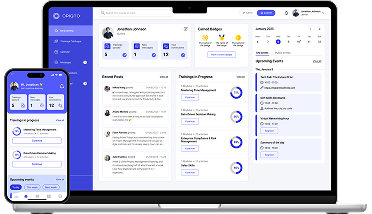The phrase “multi-tenant software” is used to describe a single application instance that is shared by multiple user groups who each have their own self-contained workspace within that application. This can include unique design elements, layouts, privileges, and features for each group.
Essentially, multiple tenants are each operating independently of one another on a single instance of a software application. They share a common infrastructure and the same database layers while having separate data storage.
With learning management systems, a multi-tenant system means that your learning and development department can operate multiple user groups — each with its own branding, custom permissions, and training objectives — within a single central hub.
What is the advantage of a multi-tenancy LMS?
The advantage of using multi-tenant LMS platforms over single-tenant LMS is that it allows you to serve a diverse set of learner groups who may each have unique training needs without having to install a new LMS for each one of them.
A multi-tenant learning management system is a cost-effective way to manage training across multiple groups of learners and users, all from a single point. A multi-tenant LMS can also be easier to maintain than a single-tenant LMS because you only need to manage one set of software updates rather than updating every instance of your LMS as in a single-tenant system.
Learn more: 3 Ways to Elevate Online Courses from Good to Great.
How can you use a multi-tenancy LMS in your organization?
There are many possible use cases for why companies may want to use a multi-tenancy LMS within their learning organization. Keep in mind that in every case, the internal staff on your L&D team retains full control over the multi-tenant system.
Multi-tenant LMS helps you meet training needs from department to department. For example, you might set up a multi-tenant LMS with workspaces for different departments, so each can manage its own users and create courses. This is especially helpful in large organizations where different departments may have unique training needs.
Multi-tenant LMS lets you set up training hubs for multiple locations. If you have an extended enterprise that spans multiple locations, a multi-tenancy LMS implementation also allows you to set up training hubs for each location. With a multi-tenant LMS, hubs can have their own branding and contain unique training content developed for that location. They can even be set up in different languages if your organization has offices in other countries.
Multi-tenant LMS means you can educate other clients outside your organization. Maybe you have external partners such as suppliers, sales partners, or clients for whom you would like to standardize training. With a multi-tenant LMS, you can set up their own training hub with custom permissions for learners from different companies. You could also sell training courses to users outside your organization.
Learn more: what is an LMS?
What should you look for in a multi-tenancy LMS?
If you want to implement a multi-tenant learning management system, look for an LMS with a multi-tenant architecture that offers the ability to manage multiple users and groups and gives you various customization and integration options. A good multi-tenant LMS will also feature in-depth reporting to help you manage your training programs.
For most businesses, it’s also worth considering the authoring tools available in multi-tenant learning management systems to help you create trainings and whether or not the multi-tenant LMS has e-commerce functionality.
Opigno LMS is a multi-tenancy learning management system that is perfectly customizable and scalable for your business objectives. Get in touch to learn how we can help.
Author: Adam Kennedy-Ripon
Design: Simon Contreras
